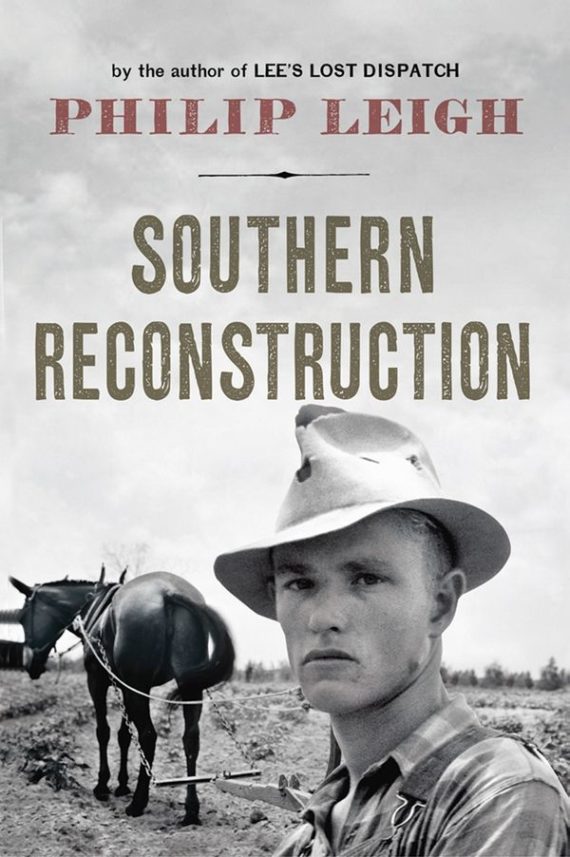A review of Southern Reconstruction by Philip Leigh (Westholme, 2017).
Confronting the establishment narrative about any historical topic can be a perilous endeavor. There are several that present such large minefields that most historians dare not attempt to cross, among them the “Civil War,” Reconstruction, and the Civil Rights movement. Bucking the accepted version of events in any of those fields is a death knell for the professional historian. Fortunately, those rules don’t apply to the “amateur” class, and Philip Leigh has proven to be one of the more promising and objective of that group. His recent tome, Southern Reconstruction, offers the best summary of the political, economic, and social dynamics of Reconstruction since William A. Dunning’s masterful turn of the century study, a work that for political reasons has been castigated by the historical establishment but never entirely refuted.
Leigh takes seriously the impact of Reconstruction on both white and black Southerners. Rather than a narrow “unfinished revolution” as Eric Foner and the modern academy view the topic, Leigh considers the era to be a tragic episode in American history, one that lasted far beyond the recognized though arbitrary end date of 1877. Dunning understood that both political and economic reconstruction continued long after troops were withdrawn from the South. Leigh agrees and points to Republican economic models as the basis for lasting Southern poverty well into the twentieth century.
Leigh paints a picture of a South devastated by the War, physically, socially, economically, and politically. Her people had been fearfully punished and would continue to be punished by Republican policies that gave no thought to the difficult transformations taking place in Dixie. His message is one of understanding, not condemnation, and while Fonerites would be compelled to declare Leigh to be little more than a Southern apologist, he has no sympathy for the systematic racial violence that took place in the “Jim Crow” era. Yet, Leigh also recognizes the role Northern voices and Northern policies had in stoking the flames, from the political and social origins of Jim Crow laws themselves to the utopian belief that racial readjustment should be financed by Southerners who had no capital to speak of after the War.
Leigh consistently punches holes in the modern “unfinished revolution” narrative and shows real sympathy for the plight of Southerners after four years of hard fighting. For example, those who believe that Southerners were not punished enough by the War, that somehow they should have been made to pay reparations or have their property confiscated, are shocked into reality. Leigh contends that Southerners did pay reparations in the form of Union veteran pensions, many of which were fraudulent and excessive, while at the same time having to come up with pennies to support their own veterans. He additionally points to the tepid interest in confiscatory policies by the majority of the Northern population, including Abraham Lincoln himself, as the reason massive land redistribution never took place. His position is not a lament for “what could have been,” but a practical understanding of what the vast majority of Americans were thinking at the time. Private property was still the cornerstone of American society, and confiscation, no matter the reason, was viewed as an immoral violation of liberty and a punitive police that very few could support. Northern self-righteousness only went so far.
Leigh makes clear that the Gilded Age would not have been possible without the political and economic corruption of Reconstruction. Northern banking and industrial interests fattened their wallets while Southerners, both white and black, faced malnutrition and few economic prospects. Southern governments controlled by “carpetbaggers” and “scalawags” raised taxes and spent lavishly. This is dangerous territory for any modern historian. The contemporary narrative argues that Reconstruction governments were models of fiscal restraint and only spent because of their overarching humanitarian concerns for the wellbeing of freedmen. Leigh calls it being “railroaded” and insists corrupt deals for railroad construction undergirded bloated state budgets. This is an almost sacrilegious assertion but one that Leigh argues well.
One gets the sense in reading Leigh’s book that the real tragedy of Reconstruction was a missed opportunity of real reconciliation, not just for the sections, but for Southerners of all races. Southern blacks were used by partisan Republicans as pawns in a larger political game, and the violent reaction of Southern whites was predictable, particularly when in some instances, Southern blacks were prodded to violence themselves by Republican Party zealots. Leigh’s chapter on “Racial Adjustment” is one of the finest in the book. He describes the difficulty in emancipation and the problems both white and black Southerners faced in adapting to new social and economic circumstances. White Southerners had no confidence in the ability of Southern blacks to become prosperous citizens, but Leigh believes that the old planter class had enough foresight and compassion to stall some of the more vicious racial violence of the 1890s, even going so far as to suggest that current interpretations of the “Redeemers” lack depth or complexity.
If Leigh’s version of Southern Reconstruction rather than Foner’s dominated our historical consciousness, the violent iconoclasm taking place in Southern towns would not exist, nor would Americans be talking about “contextualizing” statues dedicated to Washington or Jefferson or any member of the founding generation. By insisting that some “unfinished revolution” needs to take place, Foner and his acolytes have created a neo-Marxist vanguard in America determined to destroy any vestige of traditional Western Civilization. Leigh has hope that his narrative could have a calming effect on the current climate. “Just as the hippie and intellectual elites who dominated public opinion during the Vietnam War while they disparage America’s soldiers have fallen into obscurity, so also might those portraying Reconstruction as a South-as-evil-twin story might eventually fade in the face of the larger national narrative. If so, countervailing accounts like the one in this book must be told, shared, and expanded.”








One Comment